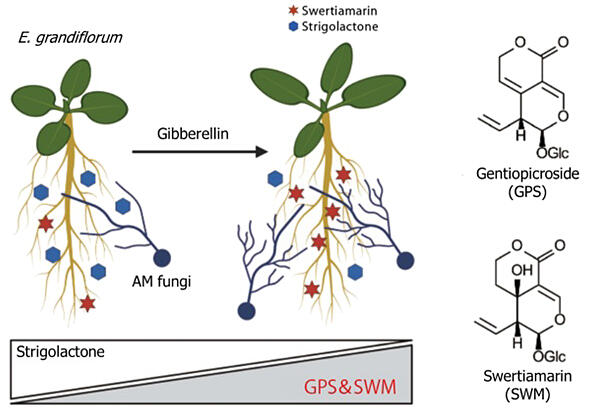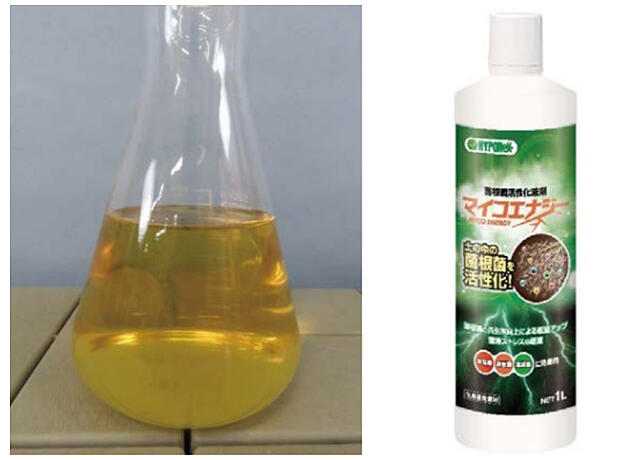In the segment 'A Look Around Innovation,' we introduce research and development (R&D) sites that have led to social implementation. In the 19th installment of this series, we introduce the efforts of Associate Professor Hironori Kaminaka of the Department of Agricultural, Life and Environmental Sciences, Faculty of Agriculture at Tottori University. He focuses on mycorrhizal symbiosis, a symbiotic relationship between plants and soil fungi, and has developed the world's first agricultural material that uses plant secondary metabolites to promote infection by mycorrhizal fungi. This material went on sale in January 2025.

Arbuscular mycorrhizal (AM) fungi supply phosphorus and nitrogen: Hormonal detection during nutrient deficiency
When JST News met Kaminaka in his laboratory in the Department of Agricultural, Life and Environmental Sciences of the Faculty of Agriculture, located on a Tottori University campus near Tottori Airport, they witnessed a variety of plants being grown under LED lighting. More than 70% of terrestrial plant species have a symbiotic relationship with AM fungi, a subgroup of fungi called mycorrhizal fungi, inside their roots. AM fungi provide inorganic nutrients, such as phosphorus, that exist outside the growth range of the roots in return for carbohydrates and fatty acids produced photosynthetically by the host plants. Such a symbiotic interaction with AM fungi allows plants to grow in nutrient-poor soils.
It has long been known that plants promote AM symbiosis by secreting promotors of hyphal branching in AM fungi from their roots. However, it has remained unknown what those promotors are exactly. In 2005, Professor Kohki Akiyama of Osaka Prefecture University (now Osaka Metropolitan University) identified the promotors as hormonal substances called "strigolactones." He discovered that plants release these hormonal substances from their roots when the soil is deficient in nutrients. AM fungi initiate hyphal branching, establishing symbiosis once they detect these substances.
Subsequent studies have revealed that when nutrients are abundantly available in the soil, host plants suppress fungal biosynthesis of strigolactones via plant hormones such as gibberellins to prevent products of photosynthesis from being taken away by AM fungi, thereby inhibiting the AM plant-fungus symbiosis. Since then, research on AM plant-fungus symbiosis has developed through studies in plants of the families Poaceae and Fabaceae, which are essential to human life. Kaminaka has been studying the symbiosis between these plants and AM fungi at the molecular level.
Selecting lisianthus to study — Large amounts of bitter components are extracted easily
During his research, Kaminaka focused on lisianthus (Eustoma grandiflorum), a member of the Gentianaceae family. "Plants growing in low-sunlight environments, such as the forest floor, cannot perform enough photosynthesis, so some depend on nutrients supplied by mycorrhizal fungi. Such plants are called 'mycoheterotrophic plants.' In mycoheterotrophic plants that can establish symbiosis with AM fungi, the symbiotic AM fungi have unusual hyphal morphology. Thus, I thought that they might also use an unusual symbiosis mechanism," he recalled. Based on this hypothesis, he selected E. grandiflorum suited for experiments from among plants of the family Gentianaceae. in which AM fungi exhibit special hyphal morphology in root cells. He initiated the study using it as a host plant.
One day in 2017, Mr. Takaya Tominaga, a student (currently a postdoctoral researcher at Nara Institute of Science and Technology), observed gibberellin-treatedE. grandiflorum roots. Against the expectation that gibberellin treatment inhibits strigolactone biosynthesis and interferes with AM fungal colonization, he observed that hyphal branching and fungal growth were stimulated, and root infection was promoted (Figure 1). The analysis results showed that gibberellin treatment increased the rate of infection by AM fungi by about 6-fold, suggesting that substances different from strigolactones stimulated the activation of AM fungi.
Figure 1:Mycorrhizal fungal infection-promoting effect of a bitter component

More experiments were conducted and revealed that gibberellin treatment increased the production of the secoiridoid glucosides "gentiopicroside" and "swertiamarin," which are plant secondary metabolites and bitter components characteristic of plants of the family Gentianaceae (Figure 2). Transcriptome analysis to determine gene expression levels also confirmed that the expression levels of genes involved in the production of both substances were increased. These bitter components serve as antimicrobial substances to protect the plants from invasion by pathogenic microorganisms. The findings indicate that they are not antimicrobial against AM fungi for some reason and promote hyphal branching in AM fungi as effectively as or more effectively than strigolactones.
Figure 2:Mechanism of hyphal branching promotion in arbuscular mycorrhizal (AM) fungi

According to Kaminaka, these results suggest that AM fungi may have acquired the ability to evade antimicrobial activity during symbiosis between AM fungi and host plants. Subsequently, he began research toward applications of bitter components that promote symbiosis with AM fungi in order to increase crop yields and reduce fertilizer use. "Mycorrhizal fungal materials to inoculate crops with AM fungi are already available, but their drawbacks include high price and unstable inoculation efficiency. Large amounts of the bitter components of Gentianaceae plants can be extracted easily. I conceived the idea that 'mycorrhizal fungal infection-promoting materials' can be produced at a low cost," he says.
Kaminaka and his colleagues demonstrated the effectiveness of gentiopicroside in promoting AM infection using chives of the genus Allium and other plants and applied for a patent. He then approached Hyponex Japan (Osaka City), which imports, manufactures, and sells fertilizers and other agricultural materials, about a possible joint research project aiming at commercialization. Because of the history of joint research with this company, Kaminaka applied as the principal investigator for the JST's A-STEP tryout in 2022, and his project was accepted.
Effective even at 100,000-fold dilution: Low-cost commercialization without purification
After the initiation of the tryout, the joint research group first engaged in the efficient extraction of the bitter components. Commercially available herbal medicines were selected as raw materials, and hot water and alcohol were used as extraction solvents. Then, the AM fungal infection effectiveness was tested in multiple plants such as chives and tomatoes, and the extracted bitter components were effective enough even at 100,000-fold dilution. At the same time, they also tested whether the bitter components would interfere with crop growth and found no problems because their concentrations were very low.
According to Kaminaka, the most important aim was to lower costs. This aim was achieved by commercializing the crude drug extract without purifying the active ingredients. With these results in hand, Hyponex Japan presented its product at "J-AGRI Tokyo 2024," held at Makuhari Messe in Chiba City in October 2024. Hyponex launched the mycorrhizal fungal infection-promoting material "MYCO ENERGY" in January 2025 (Figure 3). Kaminaka continues to collaborate with this company to this day.
Figure 3:Crude drug extract and MYCO ENERGY

In addition to these studies, Kaminaka and his colleagues are working with local growers of Japanese leek. With the aim of contributing to promoting agriculture in Tottori Prefecture, they are developing technologies to reduce fertilizer use.
Furthermore, he has added plants of the family Orchidaceae to the scope of basic research on symbiotic interactions between plants and mycorrhizal fungi. With soaring fertilizer prices, the mycorrhizal fungal infection-promoting material, which can be produced at a cost affordable for many people, can be used in combination with existing mycorrhizal fungal materials and will attract attention as a new agricultural material to reduce fertilizer use.
(Article: Shinji Moribe, Photography: Hideki Ishihara)




